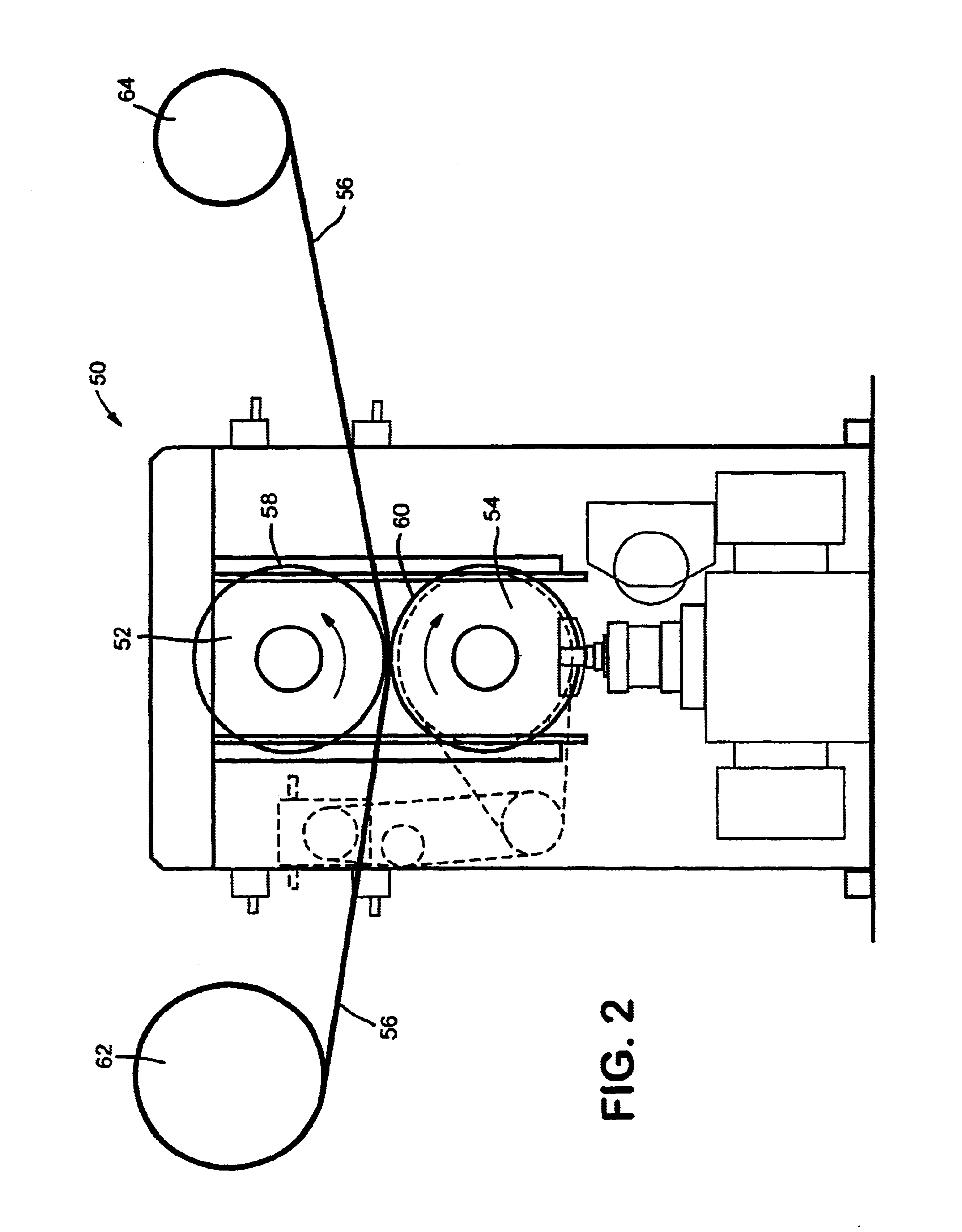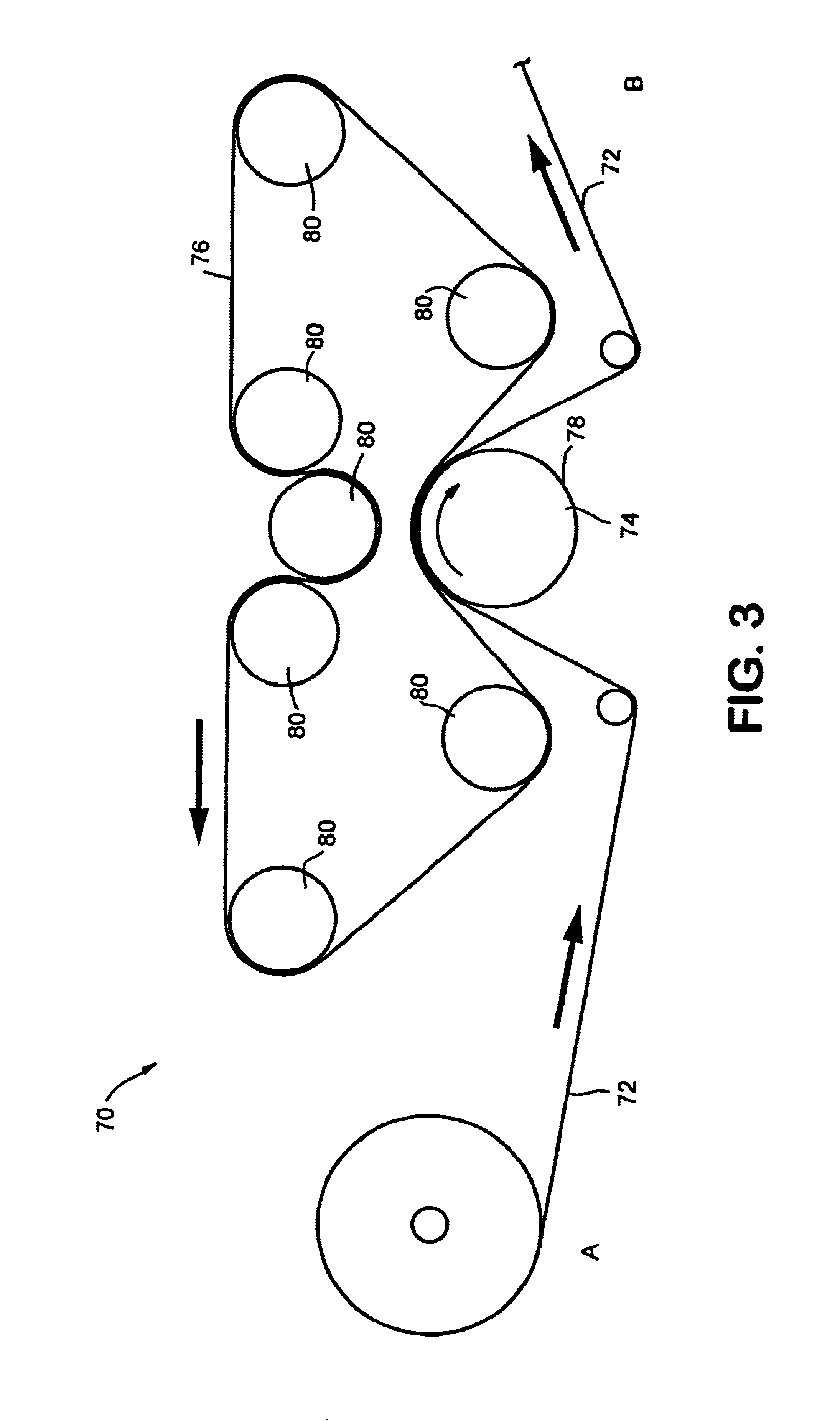Rolled single ply tissue product having high bulk, softness, and firmness
a single-ply, tissue product technology, applied in the direction of presses, manufacturing tools, instruments, etc., can solve the problems of base sheets losing a noticeable amount of bulk, multi-ply products are typically more expensive to produce than single-ply products, etc., and achieve good sheet softness and strength characteristics
- Summary
- Abstract
- Description
- Claims
- Application Information
AI Technical Summary
Benefits of technology
Problems solved by technology
Method used
Image
Examples
example 1
[0118]An uncreped through-dried bath tissue was produced by the methods described in U.S. Pat. No. 5,932,068, using a t1203-8 through-drying fabric and a t-807-1 transfer fabric, both supplied by Voith Fabrics Inc. The base web was made of 34% Northern Softwood Kraft (NSWK) and 66% Kraft eucalyptus, which was layered as follows: 33% eucalyptus / 34% NSWK / 33% eucalyptus by weight.
[0119]The eucalyptus was treated with 4.1 kg / mt active debonder and the NSWK was refined between 0 and 2.5 HPD / T with 2-3 kg / mt of PAREZ wet strength resin added. Three samples of varying tensile strength were produced by varying the refining and PAREZ wet strength addition.
[0120]The tissue was vacuum dewatered to approximately 26-28% consistency prior to entering two through-dryers and then dried in the through-dryers to approximately 1% final moisture prior to winding of the parent rolls.
[0121]A portion of the tissue was then converted using standard techniques, specifically using a single conventional polyu...
example 2
[0126]The base tissue from Example 1 above was also converted using roll-belt shearing to produce a bathroom tissue roll. This was achieved with a 2054 fabric (supplied by Voith Fabrics, Inc.), a 15% speed differential between the roll and the fabric with the roll traveling faster than the fabric, and a 65 huyck fabric tension. In the process, the fabric side of the sheet contacted the fabric, and the air side of the sheet contacted the roll.
[0127]The product was again converted to meet a finished roll product specification of a 116 mm diameter, a target roll weight of 76 g, a sheet count of 210 sheets, a Kershaw firmness of 7.5 mm and a sheet length of 104 mm. As the required roll weight was 75.8 grams, the resulting roll bulk was 12.2 cc / g. In this case the finished sheet geometric mean tensile strength was 644 grams and the fuzz-on-edge value was 1.93 mm / mm roll on the fabric side of the sheet. This product is designated Example 2 in the table below, where it is again compared to...
example 3
[0129]Finally, the products of this invention are compared to current commercial products in the table below. As is clear from the table, neither of the commercial 1-ply bath tissue products has the properties of the sample in the invention.
[0130]The first control sample is also included to facilitate comparison with the conventional calendering technique.
PUM
| Property | Measurement | Unit |
|---|---|---|
| width | aaaaa | aaaaa |
| width | aaaaa | aaaaa |
| diameter | aaaaa | aaaaa |
Abstract
Description
Claims
Application Information
 Login to View More
Login to View More - R&D
- Intellectual Property
- Life Sciences
- Materials
- Tech Scout
- Unparalleled Data Quality
- Higher Quality Content
- 60% Fewer Hallucinations
Browse by: Latest US Patents, China's latest patents, Technical Efficacy Thesaurus, Application Domain, Technology Topic, Popular Technical Reports.
© 2025 PatSnap. All rights reserved.Legal|Privacy policy|Modern Slavery Act Transparency Statement|Sitemap|About US| Contact US: help@patsnap.com



